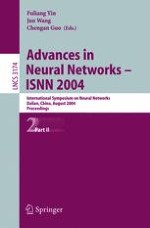This book constitutes the proceedings of the International Symposium on Neural N- works (ISNN 2004) held in Dalian, Liaoning, China duringAugust 19–21, 2004. ISNN 2004 received over 800 submissions from authors in ?ve continents (Asia, Europe, North America, South America, and Oceania), and 23 countries and regions (mainland China, Hong Kong, Taiwan, South Korea, Japan, Singapore, India, Iran, Israel, Turkey, Hungary, Poland, Germany, France, Belgium, Spain, UK, USA, Canada, Mexico, - nezuela, Chile, andAustralia). Based on reviews, the Program Committee selected 329 high-quality papers for presentation at ISNN 2004 and publication in the proceedings. The papers are organized into many topical sections under 11 major categories (theo- tical analysis; learning and optimization; support vector machines; blind source sepa- tion,independentcomponentanalysis,andprincipalcomponentanalysis;clusteringand classi?cation; robotics and control; telecommunications; signal, image and time series processing; detection, diagnostics, and computer security; biomedical applications; and other applications) covering the whole spectrum of the recent neural network research and development. In addition to the numerous contributed papers, ?ve distinguished scholars were invited to give plenary speeches at ISNN 2004. ISNN 2004 was an inaugural event. It brought together a few hundred researchers, educators,scientists,andpractitionerstothebeautifulcoastalcityDalianinnortheastern China. It provided an international forum for the participants to present new results, to discuss the state of the art, and to exchange information on emerging areas and future trends of neural network research. It also created a nice opportunity for the participants to meet colleagues and make friends who share similar research interests.
